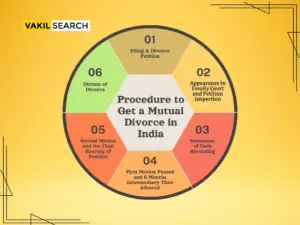Divorce by mutual consent is the simplest way to legally dissolve a marriage. Mutual consent is where both spouses agree to peacefully part from one another. It is mandatory in a divorce that both the parties agree to the marriage dissolution. If one spouse doesn’t agree to it, then the court cannot grant a divorce to the couple.While applying for a mutual consent divorce, both the parties must decide mutually on the alimony, children custody status etc. According to law, there is no specific limit related to maintenance. It depends on the financial status of both husband and wife and other aspects.
Overview on Divorce By Mutual Consent In India: It has recently been brought to the attention of the Delhi High Court that one of the provisions of the Dissolution of Muslim Marriage Act has been challenged. As a result of the provision, the petition claims that Muslim women are discriminated against. It is claimed that the provision allows a dissolution of a marriage if the husband renounces Islam or converts to another faith, but it is not permitted if the wife renounces Islam or converts to another faith. There has been a challenge to Section 4 of the Act in the petition, where it is argued that the wife cannot claim a decree of divorce based on the fact that she has converted or renounced her faith.
When Can a Married Couple File for Mutual Divorce?
Husband and wife intending to dissolve the marriage legally are expected to wait for a minimum of one year from the date of marriage.
They have to prove that they are not living together for a period of one year or more before the filing of the petition for divorce. They should also show that during this period of separation both of them have not been able to live together as husband and wife.
Where to File the Mutual Consent Divorce Petition?
The couple must file their divorce petition in the family court of the district where both the husband and wife lived together. The place must have been their matrimonial home.
What Are the Different Laws of Divorce for Different Religions in India?
Different divorce-related laws govern different religions. Hindus (which includes Sikhs, Jains, Buddhists etc.) are governed by the Hindu Marriage Act, 1955. Muslims are governed by The Muslim Women (Protection of Rights on Divorce) Act, 1986 and Personnel laws of Divorce and also the Dissolution of Marriage Act, 1939. Christians or the people who follow Christianity as religion are governed by The Indian Christian Marriage Act, 1872 and also the Indian Divorce Act, 1869. Similarly, Parsis or people from the Parsi community are governed by The Parsi Marriage & Divorce Act, 1936. And there is also another secular law called the Special Marriage Act, 1954.
How to File a Mutual Consent Divorce Petition? What Happens in the Court?
The divorce By mutual consent in India petition is a form of the affidavit, which the couple submits in the family court of the district. Once the couple files the petition, the court records statements of both the husband and wife. After that, divorce matters are adjourned for a span of six months.
After six months both husband and wife will have to present themselves again in the family court for making a second motion confirming the mutual consent which was filed earlier. Decree of the divorce is granted by the court only after this second motion. Without confirming the mutual consent in the second motion decree of divorce is not granted.
What if One of the Spouses Withdraws the Mutual Consent Divorce Petition After Filing in the Family Court?
Both the spouses are fully authorised to withdraw their consent by filing an application during the span of six months when the divorce petition is pending in the court. In such situations, the court grants no divorce decree.
What Can the Other Spouse Do Under Such Situations?
There is no alternative available to the other spouse in such cases other than filing a normal petition for the divorce under the provisions of Section 13 of the Hindu Marriage Act, 1950.
In these situations, the court grants divorce only under certain specific grounds. They are cruelty, voluntary sexual intercourse with another person, desertion, conversion of religion by the other spouse, the other spouse being of unsound mind, Leprosy, venereal disease, a spouse having abandoned the world or being missing for a period of more than 7 years etc.
How Much Span of Time Does the Whole Process Take From Filing the Mutual Consent Petition in the Court Till the Passing of the Decree (Judgement) By the Court?
It takes a minimum six months to one year from the date of filing of the petition. It is different from case to case & place to place.
Procedure to Get a Mutual Divorce in India
The above pointers explain what to do during different situations in a divorce by mutual consent in India. Let us now look at the consolidated procedure on how to get a mutual divorce in India.

-
Filing A Divorce Petition
The first step for the couple is to file a joint petition requesting the dissolution of the marriage. This couple must present the signed petition to the family court stating that they are no longer willing to live with one another. Hence agreeing to dissolve their marriage.
-
Appearance in Family Court and Petition Inspection
After filing the petition, the couple must appear before the family court with the respective council or lawyers for each side. The court will observe the petition and the other documents presented along with it. The court, in most cases, attempts to reconcile between the spouses. If proven not possible, the case proceeds to other mandated follow-ups.
-
Statement of Oath Recording
The court analyses the petition and when it satisfies all requirements, the court orders to record the couple’s statements on oath.
-
First Motion Passed and 6 Months Intermediary Time Allotted
After recording the statements, the court passes the first motion. The couple files the second motion only after the 6 months intermediary time. Sometimes the time given is between 6 to 18 from the time of the spouses’ first appearance in the family court.
-
Second Motion and the Final Hearing of Petition
When the parties decide to go ahead with the second motion, they may appear for the same and can proceed for the final hearings. Once again, the parties will have to appear in family court and record their statements.
According to the supreme court, the court can suspend the 6 month cooling period (if deemed fit). This is in case of both parties successfully settling all differences including child custody, alimony etc.
-
Dictum of Divorce
The court officially dissolves their marriage after settling the differences. The parties must mutually agree to divorce for the court to do so. Hence, it confirms the divorce.
Conclusion
If we have provided you with sufficient information regarding the matter you are concerned about, we hope that it has answered your question; however, if you require additional assistance, please do not hesitate to leave a comment below so we can help you further.




